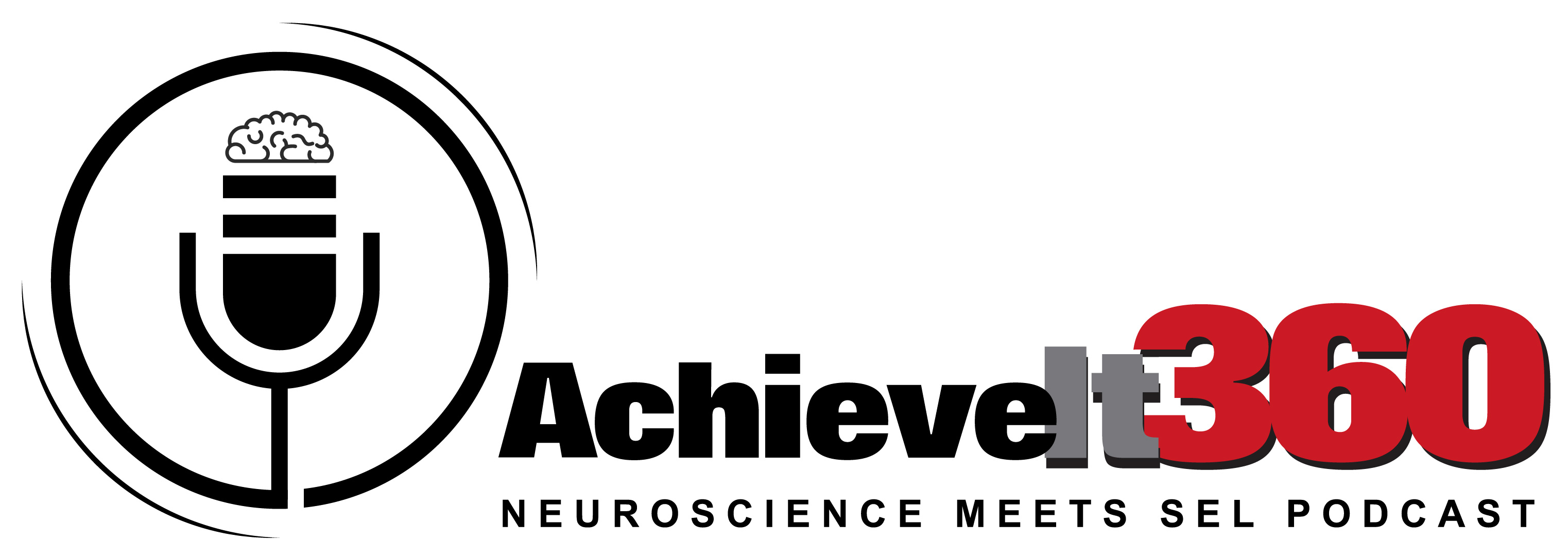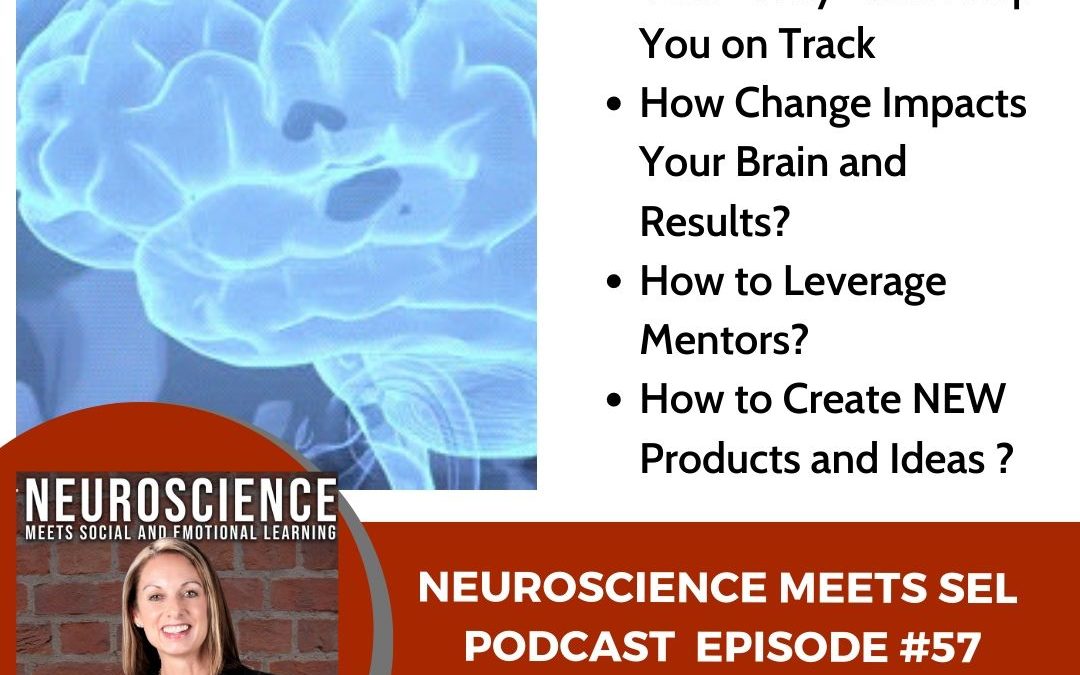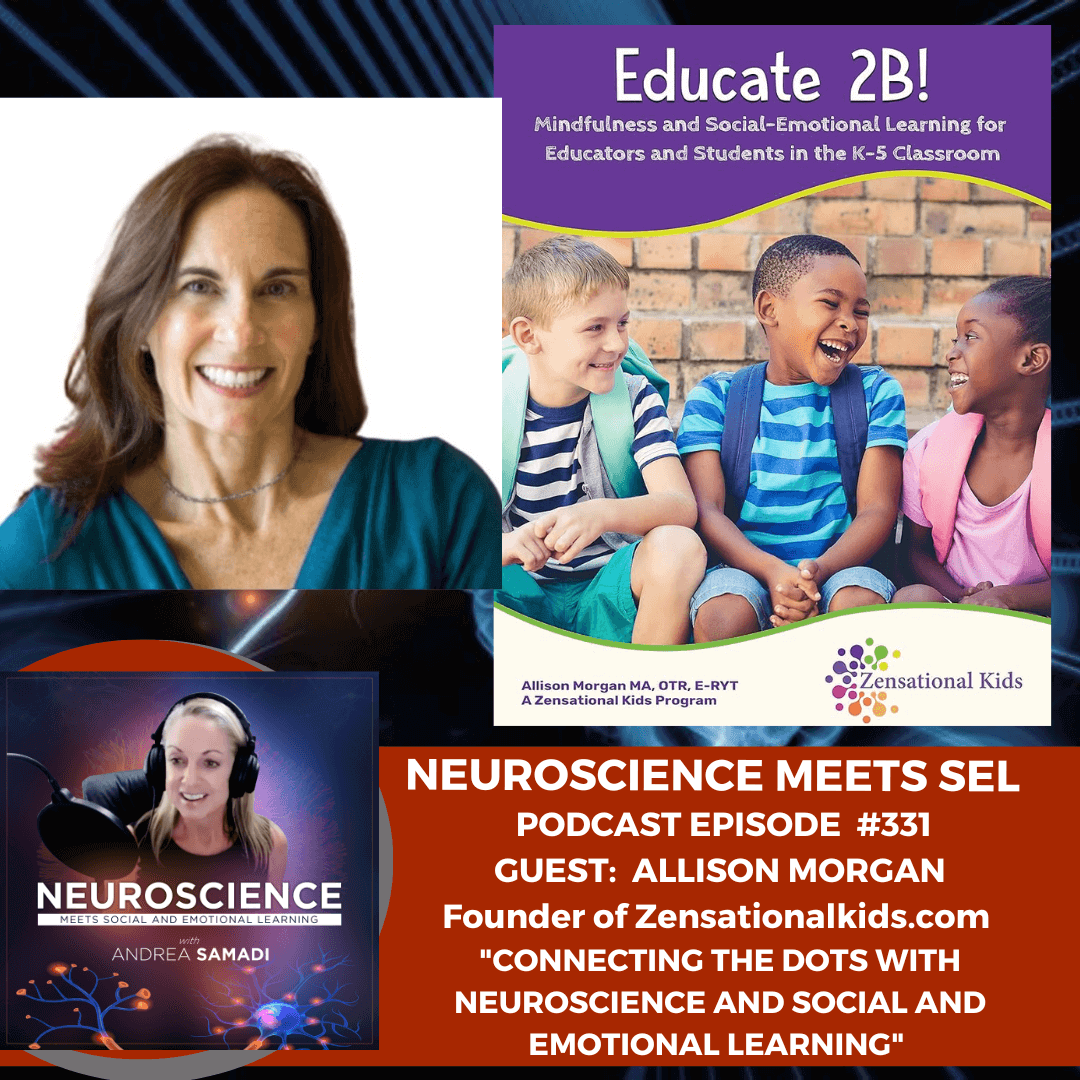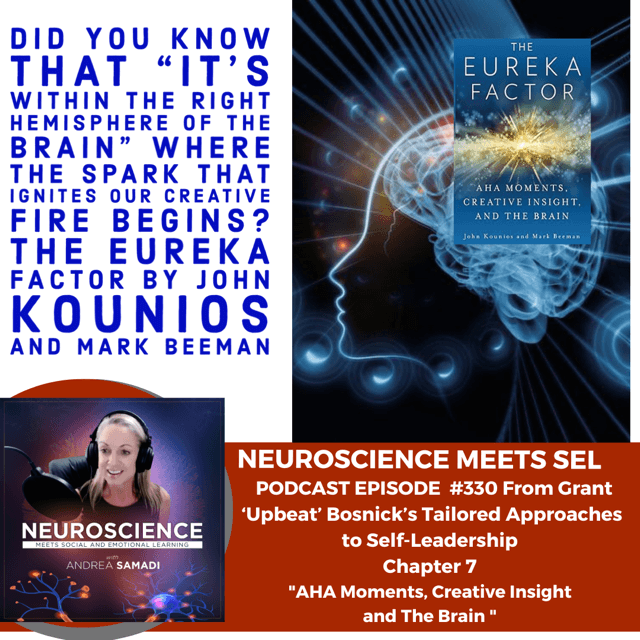This is episode #57 on “Taking Initiative, Your Brain and Change and Leveraging Mentors”
Welcome back to the Neuroscience Meets Social and Emotional Learning podcast, my name is Andrea Samadi, I’m a former educator whose been fascinated with understanding the science behind high performance strategies in schools, sports and the workplace for the past 20 years. Since you are listening to this podcast, I’m sure you are like me, and love to learn, grow, challenge yourself and always are looking for that competitive edge, these days more so than usual, I’m sure. This weekend I had a phone call from Marissa Leinert from Parent Led Academy[i] an organization helping parents to improve their skills at being better parents using social and emotional learning resources. She contacted me via LinkedIn and asked if she could brainstorm some ideas with me on the direction of her business, since she is just starting out this field. I told her to call me and sent her my number because when people take the initiative to reach out, asking for help, I think it’s important to lend a hand, share ideas, contacts and resources if you have them, and collaborate.
When we finally connected, we chatted about where she was with her company and I thought back to 20 years ago when I first wrote down the idea that turned into Achieveit360’s programs and services for schools and the workplace, and eventually this podcast. I remembered all of the people who helped me to get to where I am today and thought of a quote by Robin Sharma who said that “Everything is created twice, first in the mind and then in reality.”
If you are like Marissa, and have been thinking about an idea that you want to pursue, maybe a new direction for your career, a new product that you want to create, or something and you just aren’t sure of even where to begin, this episode is for you. This episode will focus on some key starting points so you can follow the steps and get moving with something new. Whatever idea you have, that you might be thinking about, start with writing it out, and then expand on your vision by writing down some ideas and see where you can begin to take action. I was lucky enough to have met some of the top leaders in the country who shared their secrets with me over 20 years ago when I first started and I felt that since I had this opportunity, that I had an obligation to take action with the strategies and tips they shared with me. Now that I am being asked more often, how did you get started with this idea, I thought I would share with you the process that I used and hope you find these ideas helpful.
Step 1: “Know Your Why” Which Also Can Be Seen as “Know Your Values”
Simon Sinek[ii] built his career from this idea and before starting anything new, I always suggest revisiting Simon’s “Golden Circle”[iii] where he talks about the importance of knowing your “Why, Your Purpose, What You Believe.” If everyone in your organization knows this for themselves, then it will be easy to motivate each person towards the common organizational goal. Before any pivot you make, go back and look at your purpose and make sure the new direction aligns to this your why, purpose or values. The “How” or your process will come easy once you’ve identified your “Why” and the “What” you do, or end result will naturally follow.
What you believe can also be seen as your values. Once you know the values that are important to you and your organization, everything else becomes crystal clear.
For me, I know that we believe that well-being equals achievement and productivity, (with physical and mental health being my #1 value). Everything we create/market/sell/produce must help improve well-being that will lead to an increase of productivity, achievement and results. What are your highest values? Go back and listen to episode 2 “Self-Awareness: Know Thyself”[iv] where we dive deeper into uncovering your values or what’s important in your personal and professional life to ensure happiness.
Remember: To “know thyself” is the most substantial achievement we can have in our lifetime.” Jim Rohn, an American author, speaker and entrepreneur reminds us that “The major value in life is not what you get. It’s what you become.”
Step 2: Recognize the “Change Barrier” and the Need for Safety in Your Brain
This topic is something that we aren’t taught in school so many of us when faced with trying something new, or pivoting to a new direction, are hit with what I write about in the Level Up[v] book (lesson 7) called “The Change Barrier.” It’s the fear that hits us from a subconscious level when we begin a new idea. Whenever there is a major shift in your life, you will find yourself face-to-face with this “Change Barrier” that’s like a brick wall and wants to keep you safe, in your old world. When you are making a decision and you start to feel that sinking feeling in the pit of your stomach, recognize this as hitting the “Change Barrier.” Your entire central nervous system goes off as you think about the new thought or idea in your conscious mind, that challenges you to do something you have never done before. You might have some automatic negative thoughts that cross your mind that say things like “who are you to try something new, don’t waste your time, this idea didn’t work the last time you tried it” or something like that. You will need to have strategies in place to help you to move past this stage in the direction of your goals, instead of quitting, that will happen if you don’t properly prepare.
Remember that the panic you feel is real. What’s actually happening, is the amygdala (in your limbic/emotional brain) begins to fire when it’s recognizing that something is an actual or perceived threat. The amygdala acts like a thermostat and fires as stress and anxiety rise. High levels of stress hormone cortisol flood your body and it tries to get you to stop taking the actions that are causing the anxiety and go back to safety or your old world. You can either keep going and move beyond the fear or go back to safety and comfort. That feeling doesn’t go away until with time and practice we have infused the new idea into our brain, creating the new neural pathway of this new idea, and we finally get to that place of freedom, where we no longer feel uncomfortable with the new idea. We have bypassed fear and anxiety and stepped forward, to growth.
This one takes some self-awareness as well, as years into your new role, it is common to have doubts and fears around this new position. I remember speaking to a very successful CEO of a large company, and he shared with me that there are many days he sits at his desk and marvels at how someone with his background could have reached the heights of success that he was living on a daily basis. It’s important to remember to integrate your success into your new life. Celebrate your small and large wins, so that they sink in at the non-conscious level in your brain. On those few days that you experience self-doubt, take a break and do something that you enjoy. Be kind to yourself and remember that you do deserve everything that you have earned.
Step 3: Find Your Mentors
I was lucky enough to have crossed paths with some powerful thinkers in my late 20s who got me started on this journey of creating, developing and launching new ideas. Speaking with Marissa this weekend, reminded me that at this point in many of our lives, we are thinking of new ways of conducting business. If we were used to doing live trainings in the past, many of us have adapted to online training. If we have never done this before, we will want to look for mentors to help us to gain the confidence we need with our new business models. With confidence, we build competence with our new skills and eventually they become second nature.
If you say “well, I don’t know any powerful leaders to ask for their advice” don’t quit just yet. Keep looking and as you might have heard before, “when the student is ready, the teacher will appear.”
Stay 4: Keep an Open Mind In 2014 when I was looking to take my programs and services online, like many people are doing now, I found a mentor to show me everything I needed to know and he was unlike anyone I had ever worked with in the past. His name is Austin Walsh[vi], and at the time, he was a high school student living in Chicago. I had to wait for him to finish classes to return my calls, as he worked with me over Skype on creating the membership area of my website where all of our content is hosted. He had worked with some of the speakers I knew (Les Brown and Mark Victor Hansen from the Chicken Soup for the Soul books) so he came highly recommended and I’m still amazed at how this then-16-year-old knew so much about the online world. I learned so much from him and would still say he’s one of my most memorable mentors.
Step 5: Manage Your Relationships In my late 20s, I was fortunate to have met many world leaders when I worked in the motivational speaking industry. Always stay in contact with people you meet as you never know who will continue to impact you in your future.
One powerful influencer I met in 2001 was Greg Link, who partnered with Stephen Covey to form CoveyLink.org and co-author “Smart Trust: The Defining Skill That Transforms Managers into Leaders.”[vii] He saw my interest in youth development while he was very busy building the Covey empire and taking the “7 Habits of Highly Effective People[viii]” book to impact millions of people worldwide, but I kept in touch with him over the years. He always was there with ideas, business model suggestions for my programs for the school market, and just plain inspiration to keep going. It’s been a few years since I have seen Greg, but as I was writing the outline for this episode this past weekend, I heard from Greg via Linkedin and it made me realize the importance of keeping in touch with your connections and then helping others (like Marissa) who need your help. See Greg’s testimonial of our work 7 years ago.[ix]
Step 6: Be Open to Ongoing Learning When you surround yourself with others who put value on learning/growth, you will inherit new ideas that you can implement for your own business growth. There is always someone who has done what you are looking to do, and with success, so keep learning, attending conferences (when they are back up and running) and networking with those people you see leading in your field.
Before I launched the Level Up [x]program for the school market, I attended a class called the “Make, Market and Launch It[xi]” based on the book by Pam Hendrickson and Mike Koenigs. If you are looking to launch a product, I highly recommend this book that you can get right away on Amazon. You will learn the 7 most important steps to making or creating your product, and then launching it to the market of your choice.
Always think about the problem that you are looking to solve which is Shark Tank’s Robert Herjavec’s #1 tip for entrepreneurs.[xii] He suggests that the best businesses are ones that “find a problem and then solve it.”
Once you have created your product (whether it’s a book, online course) or whatever it might be, then get feedback from your audience. Don’t ask your sister or your Mom for their feedback—they will lie. Be prepared for someone to tell you it’s awful, ugly, the worst idea ever, and listen to what they say. Take that feedback to improve what you have created
I hope you have found these 6 tips useful. I would love to hear what you think. Send me a message through LinkedIn, or Twitter, and I look forward to seeing you on the next episode with an exciting new guest from Australia. See you soon.
REFERENCES:
[i] Parent Led Academy an SEL Resource to Help Parents Improve Their Skills https://parentledacademy.org/
[ii] Simon Sinek https://simonsinek.com/commit/start-with-why/
[iii] https://www.freshworks.com/freshsales-crm/resources/summary-of-start-with-why-blog/
[iv] Neuroscience Meets SEL Podcast EPISODE #2 “Self-Awareness: Know Thyself” https://podcasts.apple.com/us/podcast/self-awareness-know-thyself/id1469683141?i=1000443474075
[v] Level Up: A Brain-Based Strategy to Skyrocket Student Success and Achievement by Andrea Samadi (Wheatmark, 2015) https://www.amazon.com/Level-Up-Brain-Based-Skyrocket-Achievement/dp/1627872647
[vi] Austin William Walsh https://www.facebook.com/pg/walsh.austin/posts/
[vii] Smart Trust: The Defining Skill That Transforms Managers into Leaders by Stephen Covey and Greg Link https://www.amazon.com/Smart-Trust-Defining-Transforms-Managers/dp/1451652178
[viii] 7 Habits of Highly Effective People by Stephen Covey https://en.wikipedia.org/wiki/The_7_Habits_of_Highly_Effective_People
[ix] Greg Link Testimonial of Achieveit360 and Andrea Samadi https://www.youtube.com/watch?v=G_z_d6iBdfw
[x] Level Up Online by Andrea Samadi https://www.achieveit360.com/level-up-online/
[xi] Make, Market Launch It by Pam Hendrickson and Mike Koenigs (2013) https://www.amazon.com/Make-Market-Launch-Ultimate-Creation-ebook/dp/B00B9JKODO
[xii] Shark Tank’s Robert Herjavec’s Top 5 Business Tips for Entrepreneurs (May 16, 2019) by Abby Narishkin and Jack Houston https://www.businessinsider.com/shark-tank-robert-herjavec-top-business-tips-entrepreneurs-2019-5
Podcast: Play in new window | Download
Subscribe: Apple Podcasts | RSS












